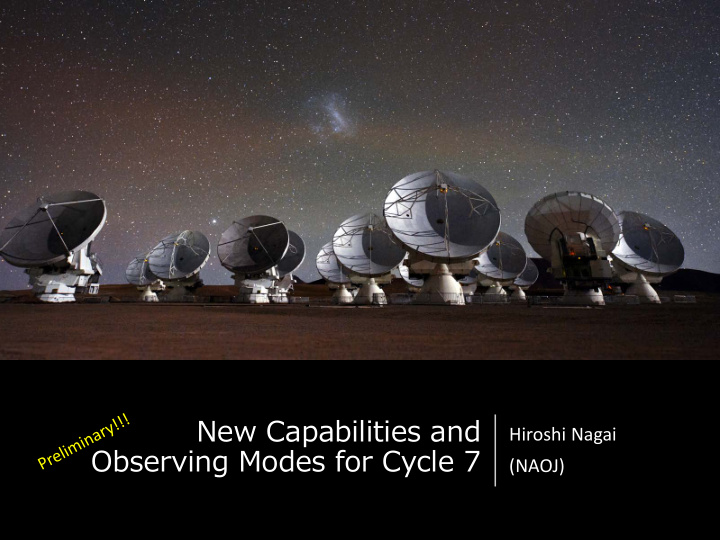



New Capabilities and Hiroshi Nagai Observing Modes for Cycle 7 (NAOJ)
General information • 4300 hours of 12-m Array time, and 3000 hours of ACA (Morita Array) • The same proposal types as in the previous cycle will be accepted. • PI submitting a proposal to ALMA+GMVA at 3mm must also submit a proposal to the GMVA by Feb. 1, 2019. • Supplemental Call for stand-alone ACA will be issued in September 2019 (Will explain later).
Timeline 19 December 2018 Cycle 7 pre-announcement Release of the ALMA Cycle 7 Call for 19 March 2019 (15:00 UT) Proposals and Observing Tool, and opening of archive for proposal submission 17 April 2019 (15:00 UT) Proposal submission deadline Result of the proposal review sent to End of July 2019 proposers Deadline for phase 2 submission by 5 September 2019 proposers October 2019 Start of Cycle 7 observations September 2020 End of Cycle 7 observations
What’s New? • Observations in Band 7 in configurations C43-9 and C43-10 (θ beam ~10 mas). • Solar observations in Band 7 in configurations C43-1 and C43-2. • Solar observations in one additional configuration (C43-4) in Band 3. • Improved sensitivity limit for full spectral resolution linear polarization observations (same for TDM). • Spectral scan as a standard mode. • Band 7 LB will become a standard mode as long as a suitable phase calibrator is found within 5 deg of the science target. • Data rate will be significantly relaxed.
Non standard modes (up to 20%) • Band 7 observations with baselines longer than 5 km if the phase calibrator is expected to be further than 5 degrees from the science target (the Observing Tool used for proposal submission will assess the availability of suitable phase calibrators and will issue a warning in such a case) • Band 9 and 10 observations • All polarization observations • Bandwidth switching projects (less than 0.9375 GHz aggregate bandwidths over all spectral windows) • Solar observations • VLBI observations • User-specified calibrations • Astrometry
Some highlights for technical capabilities • Antennas • At least forty-three antennas in the 12-m Array • At least ten 7-m antennas and three 12-m antennas in the ACA • Configurations • Maximum baselines of 3.6 km for Bands 8, 9 and 10 • Maximum baselines of 16.2 km for Bands 3 to 7 • Spectral line, mosaic • Single field interferometry (all bands) and mosaics (Bands 3 to 9) with the 12-m Array and the 7-m Array • Single dish spectral line observations in Bands 3 to 8
Some highlights for technical capabilities • Polarization • Single pointing, on axis, full, linear and circular polarization for both continuum and full-spectral-resolution observations in Band 3, 4, 5, 6, and 7 on the 12-m Array. The FoV of linear and circular polarization observations is limited to the inner 1/3 and 1/10 of the primary beam, respectively. • Linear polarization imaging of a compact source on-axis in both continuum and full spectral resolution modes is feasible at the level of 0.1% (3 sigma) fractional polarization for the very brightest calibrators, and 0.2% (3 sigma) level for a typical observation. • The minimum detectable degree of circular polarization is 1.8% of the peak flux for both continuum and full spectral resolution observations.
Configuration Schedule LST for best observing Start date Configuration Longest baseline conditions 2019 October 1 C43-4 0.78 km ~ 22—10 h 2019 October 20 C43-3 0.50 km ~ 23—11 h 2019 November 10 C43-2 0.31 km ~ 1—13 h 2019 November 30 C43-1 0.16 km ~ 2—14 h 2019 December 20 C43-2 0.31 km ~ 4—15 h 2020 January 10 C43-3 0.50 km ~ 5—17 h 2020 February 1 No observations due to maintenance 2020 March 1 C43-4 0.78 km ~ 8—21 h 2020 March 20 C43-5 1.4 km ~ 9—23 h 2020 April 20 C43-6 2.5 km ~ 11—1 h 2020 May 20 C43-7 3.6 km ~ 13—3 h 2020 June 20 C43-8 8.5 km ~ 15—5 h 2020 July 11 C43-9 13.9 km ~16—6 h 2020 July 30 C43-10 16.2 km ~17—7 h 2020 August 20 C43-9 13.9 km ~19—8 h 2020 September 10 C43-8 8.5 km ~20—9 h
Stand-alone ACA Supplemental Call • Will be issued on 3 September 2019 with a proposal deadline on 1 October 2019 • The Supplemental Call will maximize the scientific output of the ACA by allowing more timely science to be proposed since the Supplemental Call will follow the Main Call by five months. • A minimum of 750 h of observing time on the ACA will be allocated between January 2020 and September 2020. • Only regular proposals without time constraints will be allowed. • Approved proposals in the supplemental call will have Grade C. • Will be peer reviewed through a distributed system, in which the PI of each submitted proposal, or a designated reviewer selected from among the co-Is of the proposal, will be responsible for reviewing ten proposals submitted in the same call.
FAQ page for the Supplemental Call • https://almascience.nao.ac.jp/proposing/7m-array- supplemental-call
• https://almascience.nao.ac.jp/news/alma-cycle-7-pre- announcement
Recommend
More recommend